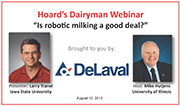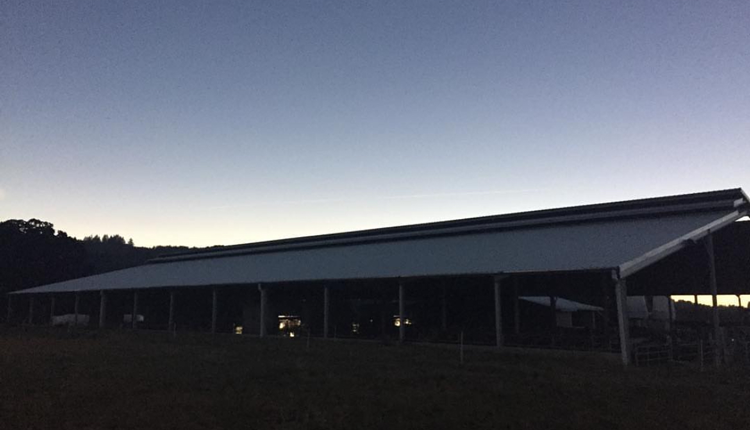 Larry Tranel, Iowa State University, spoke on robotic milking during the August 12 Hoard's Dairyman webinar, titled "Is robotic milking a good deal?" His noon-time presentation covered a cross-section of financial and management considerations when contemplating installing automatic milking systems (AMS).
Larry Tranel, Iowa State University, spoke on robotic milking during the August 12 Hoard's Dairyman webinar, titled "Is robotic milking a good deal?" His noon-time presentation covered a cross-section of financial and management considerations when contemplating installing automatic milking systems (AMS).There are currently 22,000 robotic units installed in the world to milk dairy cows, and that number is expected to continue its uphill climb. They are used in conjuction with freestall housing, bedded packs and pasture-based operations. There are four primary companies that sell robotic milking systems. Your individual herd circumstances and unique benefits of each company's product will determine the best fit. Tranel advises those interested in this new technology to do their research and speak to companies, but also to other producers using the technology and other advisers. It is a large investment and you want to be sure you have asked and had all your questions answered before proceeding.
While some dairies milk twice or three times daily, cows milked with robotic systems can set their own schedule. The average milking per cow per day is between 2.4 and 3.0. Cows earlier in lactation will prefer to be milked more often. However, the sophisticated software alerts the dairy producer if a cow is not being milked regularly, indicating a health or management issue.
One robotic unit, which can handle 55 to 60 cows, costs about $180,000 to $220,000. And, depending on the producer's desire to frequently update equipment and/or software, can last for seven to 15 years.
There will be labor savings in the form of fewer hours spent milking cows, but additional time will be spent analyzing the data and using the tremendous amount of information the computer can generate. Time spent looking at reports and then utilizing the data shows a decrease of 4 days to first breeding, a drop of six days to conception and a calving interval of 7 days less.
Two robots can save a producer $102,471 in labor, chemicals and water usage. However, there will be higher electrical costs, and of course, the initial cost of the units. Somatic cell counts were virtually unchanged from traditional milking barn to robots. Tranel presented extensive slides on the financial viability of robot investments. You can find a spreadsheet at extension.iastate.edu/dairyteam. The Excel file is the fourth item listed.
Other considerations included barn design. You want well-lit areas near the robots to entice cows to enter the units. Provide water readily available near the exit so cows can drink after being milked without blocking others from entering the unit. Design and cow flow are important because dominant or aggressive cows can deter more timid ones from entering the milking unit.
Cows eat a pelleted feed while being milked. Pelleted feed reduces dustiness which can wear out equipment more rapidly. Nutritionists must also consider the feed value in the pelleted feed consumed while milking when balancing herd rations.
Quality of life is seen as a large benefit to using robots to milk. However, someone needs to be ready 24/7 to handle any issues with the machinery. The software automatically sends alerts to the producer's phone when a problem arises. A backup electricity generator is highly recommended – both with robots or without.
When a new system is installed there is a learning curve for the cows as well as the producers. A trained representative from the robot company generally assists with adapting the cows to the new milking routine for the first few milkings. "The people adapting to the robots takes longer than the robots take to milk the cows," commented Tranel.
So, is robotic milking right for you?
The three key items that should influence your decision to use robotic milkers are:
- Initial investment cost and the salvage value. Can you afford the investment? Will there be some value to the unit after multiple years to resell to another producer?
- Interest rate – what is the added cost of this purchase. If you are using cash reserves, place a value on that as well, as "opportunity costs" where that money could be earning money elsewhere.
- Milk production – robots will boost milk production in a 2x herd by about 10 percent. But if you are constructing a new sand-bedded freestall barn, you may be getting more production from cow comfort and the robot increases will be less substantial. Also, those milking three times a day will not see the jump either, as cows are only milked about 2.5 times per day by robots.
This webinar was sponsored by DeLaval VMS. The August webinar is archived and available for viewing.

The author is the online media manager and is responsible for the website, webinars and social media. A graduate of Modesto Junior College and Fresno State, she was raised on a California dairy and frequently blogs on youth programs and consumer issues.











